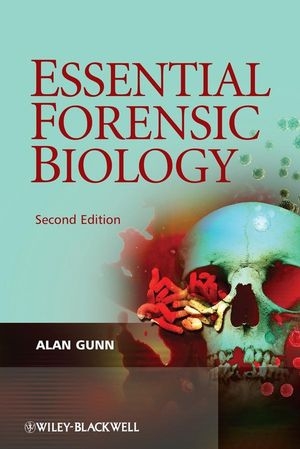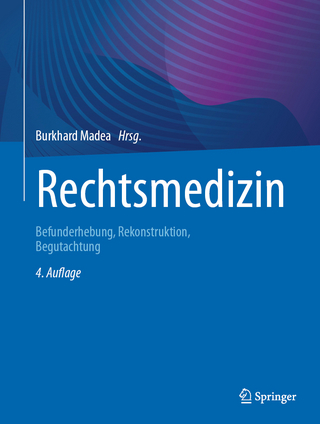
Essential Forensic Biology
Wiley-Blackwell (Verlag)
978-0-470-75804-5 (ISBN)
- Titel erscheint in neuer Auflage
- Artikel merken
* Now in full colour throughout. * Includes a supplementary website (www.wileyeurope.com/college/gunn) covering additional material and self-test questions to reinforce student understanding. From the reviews of the first edition: "The author does an excellent job of demonstrating how biological science can, and does, contribute to legal investigations..." THE QUARTERLY REVIEW OF BIOLOGY "...a super book ...not a book that will languish on library shelves. Buy it!" JOURNAL OF BIOLOGICAL EDUCATION "...naturalists and biologists will find much of interest within these books...new light on the application of their own specialism..." THE NATURALIST "Overall, I give it my highest recommendation. I was unable to find a single paragraph that was no fascinating, despite being sad or gruesome at times." E-STREAMS
Dr Alan Gunn, Senior Lecturer; Programme Leader: Biology and Zoology; School of Biological and Earth Sciences, Liverpool John Moores University.
Contents Acknowledgements Introduction PART A: HUMAN REMAINS: DECAY, DNA, TISSUES AND FLUIDS Chapter One: The decay, discovery and recovery of human bodies The dead body The stages of decomposition Factors affecting the speed of decay Discovery and recovery of human remains Determining the age and provenance of skeletonized remains Future developments Chapter Two: Body fluids and waste products Blood cells and blood typing Methods for detecting blood Confirming the presence of blood Bloodstain pattern analysis Artificial blood Post mortem toxicological analysis of blood Saliva and semen Vitreous humor Faeces and urine as forensic indicators Future directions Chapter Three: Molecular biology The structure of DNA DNA sampling DNA profiling Polymerase chain reaction Short tandem repeat markers Single nucleotide polymorphism markers Determination of ethnicity Determination of physical appearance Determination of personality traits Mobile element insertion polymorphisms Mitochondrial DNA RNA DNA databases Future developments Chapter Four: Human tissues The outer body surface Hair Bones Teeth Future developments Chapter Five: Wounds Definitions Blunt force injuries Sharp force traumas Bone damage Additional aspects of wound interpretation Asphyxia Pathology associated with drug use Gunshot wounds Bite marks Burns and scalds Ageing of wounds Post mortem injuries Future developments PART B: INVERTEBRATES AND VERTEBRATES Chapter Six: Invertebrates 1: biological aspects An introduction to invertebrate biology Invertebrates as forensic indicators in cases of murder or suspicious death Invertebrates as a cause of death Invertebrates as forensic indicators in cases of neglect and animal welfare The role of invertebrates in food spoilage and hygiene litigation The illegal trade in invertebrates Invertebrate identification techniques Future directions Chapter Seven: Invertebrates 2: practical aspects Calculating the PMI/time since infestation from invertebrate development rates Complicating factors affecting earliest oviposition date calculations Determination of the PMI using invertebrate species composition Determination of the PMI using ectoparasites Determination of movement from invertebrate evidence Invertebrate evidence in cases of wound myiasis and neglect Detection of drugs, toxins and other chemicals in invertebrates Obtaining human/vertebrate DNA evidence from invertebrates Determining the source and duration of invertebrate infestations of food products Collecting invertebrates for forensic analysis Killing and preserving techniques for invertebrates Future directions Chapter Eight: Vertebrates Introduction Vertebrate scavenging of human corpses Vertebrates causing death and injury Neglect and abuse of vertebrates Vertebrates and drugs Vertebrates and food hygiene Illegal trade and killing of protected species of vertebrates Identification of vertebrates Future directions PART C: PROTISTS, FUNGI, PLANTS AND MICROBES Chapter Nine: Protists, fungi and plants Introduction Protists Fungi Plants Plant secondary metabolites as sources of drugs and poisons Illegal trade in protected plant species Future directions Chapter Ten: Bacteria and viruses Introduction The role of microorganisms in the decomposition process Microbial profiles as identification tools Microbial infections and human behaviour Microbial infections that can be mistaken for signs of criminal activity The use of microorganisms in bioterrorism Future directions References Index
| Erscheint lt. Verlag | 23.1.2009 |
|---|---|
| Verlagsort | Hoboken |
| Sprache | englisch |
| Maße | 174 x 247 mm |
| Gewicht | 1082 g |
| Themenwelt | Studium ► 2. Studienabschnitt (Klinik) ► Rechtsmedizin |
| Naturwissenschaften ► Biologie ► Mikrobiologie / Immunologie | |
| ISBN-10 | 0-470-75804-X / 047075804X |
| ISBN-13 | 978-0-470-75804-5 / 9780470758045 |
| Zustand | Neuware |
| Haben Sie eine Frage zum Produkt? |
aus dem Bereich



